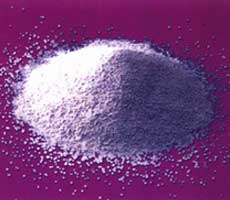Our range of Antimony trioxide is produced from stibnite ores (antimony trisulfide) or as a by-product of lead smelting and production. Antimony Trioxide is used mainly in fire retardant formulations for plastics, rubbers, textiles, paper and paints. Further, Antimony Trioxide can be used as an additive in glass and ceramic products and as a catalyst in the chemical industry. Occupational exposure may occur during mining, processing and smelting of antimony ores, in glass and ceramics production, and during the manufacture and use of products containing antimony trioxide. Antimony trioxide and pentoxide do not react as flame-retardants directly. Antimony Trioxide are used as synergists to enhance the activity of halogenated flame-retardants by stepwise releasing the halogenated radicals to retard gas phase chain reaction of flame spread.

| Specification Of Antimony Trioxide : | |
| Sb2O3 | 99.5% MIN |
| Al2O3 /As | 0.06% MAX |
| PbO/Pb | 0.1% MAX |
| Fe2O3 /Fe | 0.006% MAX |
| Cu | 0.002% MAX |
| Se | 0.005% MAX |
| Whiteness | 95% MIN |